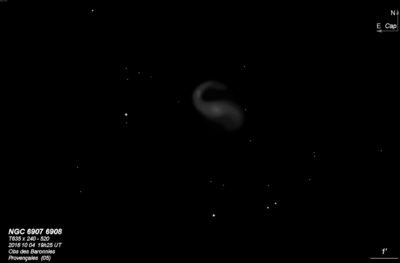
William Herschel discovered NGC 6907 = H III-141 = h2076 on 12 Jul 1784 (sweep 236) and recorded "a pretty considerable vF nebula, lE, vlbM than at the extremes. 240 showed the same appearance; it makes a trapezium with 3 stars and is at the northern and following corner of it." JH made the single observation (from Slough), "vF; L; R; vglbM; 3' diam; r; the sky hazy." His position is accurate. In a 5-inch refractor at Vanderbilt, Barnard called it "faint and somewhat faint; it is close preceding a 9-magnitude star, and is gradually pretty much brighter in the middle."
400/500mm - 17.5" (8/8/02): beautiful view at 220x. This barred spiral appeared moderately bright and large with a fairly bright bar elongated "bar" oriented ~E-W with a small bright core. At the following end of the bar an obvious arm is attached is attached sweeping north of the galaxy in a comma-like appendage. On the preceding end there seems to be a faint knot and there is a very short extension bending south that quickly fades out.
17.5" (9/14/85): at 192x appears moderately bright, bright core, elongated E-W. Barred spiral structure is evident; fainter extensions form the bar and an arm at the eastern end of the bar curves north and then hooks slightly back to the west. This spiral arm appears to end at a faint knot. Two mag 11.5 stars lie 3' E and a similar distance south.
600/800mm - 24" (8/14/15): the companion galaxy superimposed on the eastern arm was clearly visible and fairly well defined, elongated 5:2 N-S, ~20"x8".
24" (7/25/14): striking example of a barred spiral with a prominent 1.5'x0.5' central bar oriented directly east-west. The bar contains a bright 30" core, which increases to a quasi-stellar nucleus. A bright arm is attached at the east end of the bar and extends due north for 0.7', at a right angle to the bar. A bright, elongated N-S "knot" is embedded in the middle (superimposed companion NGC 6908). At the north end, the arm curls west a short distance while dimming out. A difficult, ill-defined arm is attached at the west end of the bar. It vaguely curves south and west, but quickly disappears into very low surface brightness haze.
24" (9/15/12): excellent barred spiral with the 1.5' central bar oriented E-W. The bar has a small, brighter core that increases to a faint stellar nucleus. On the east side of the bar a prominent spiral arm is attached that hooks at a 90° angle to the north for ~45". The arm dims and curves clockwise to the west a short distance, creating a "comma" appearance in the eyepiece with north down and west left. There is a noticeable elongated brightening or N-S streak in the arm at the northern end (before curving west). This streak is NGC 6908, a superimposed companion. On the west side of the bar, the beginning of a low surface brightness arm (hazy extension) bends southwest a very short distance and dims out.
900/1200mm - 48" (10/25/14): the central 1.2' bar of NGC 6907 runs E-W and contained a bright core and very bright nucleus that increased to the center. The more prominent spiral arm is attached on the east end of the bar and the section that hooks north contains NGC 6908, a superimposed galaxy. It appeared fairly bright, elongated 3:1 N-S, ~21"x7", very small bright core -- and appeared distinctly as a separate galaxy. A mag 16 star is just off the northeast end of NGC 6908. The arm bends clockwise west and dims as it extends to nearly the west end of the central bar (much further than seen with my 24"). The southern arm was fainter, more diffuse and broader, but swept around to the east on the south side of the halo, reaching nearly to the east end of the central bar. Two non-stellar HII knots (~10" diameter) were seen along this arm and they made an equilateral triangle with the nucleus; the brighter knot is at the west end of this arm, 0.8' SE of center, and a second knot lies 0.8' SSW of center.
Notes by Steve Gottlieb